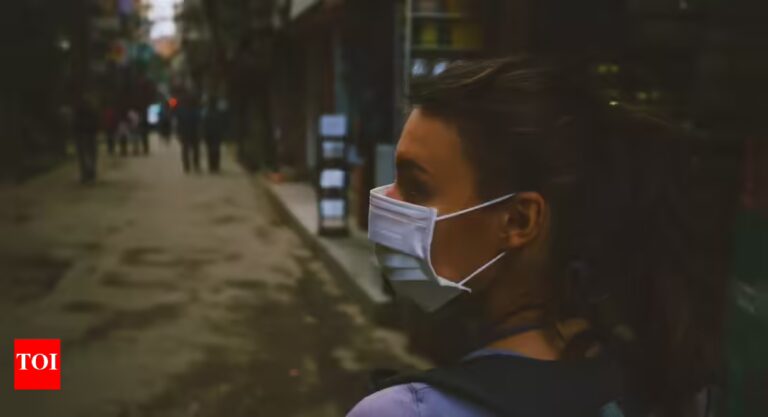Residents of the National Capital and its suburbs woke this Sunday morning to a dense blanket of haze and smog, with official monitoring systems recording a sharp deterioration in air quality. According to the latest figures from the Air Quality Early Warning System for Delhi (Ministry of Earth Sciences, Govt. of India), the city registered an Air Quality Index (AQI) of 318 today, placing the air quality firmly in the “Very Poor” range. The AQI is expected to go over 340. The reading marks a notable downturn from recent days. On Saturday (October 25) the AQI stood at 257 as of 5:30 am, and on Friday morning it was recorded at 293, both of which fall into the “Poor” range but show a clear worsening trend. With today’s jump past the 300 mark, the city’s air has moved into a more hazardous bracket.
Delhi Smog Worsens Two Days After Diwali, AQI Hits Very Poor Levels
Monitoring stations across the city indicate localised extremes of pollution. At the east Delhi station of Anand Vihar, the AQI surged to 318 this morning. Other hotspots include Chanakya Place, the DR Karni Singh Shooting Range in south Delhi, and the Goutampuri monitoring location, all reporting significantly elevated levels. It is worth noting that differences persist between readings from the EWS, the Central Pollution Control Board (CPCB) and private trackers such as aqi.in.Under India’s AQI categorisation system:
- 0–50: Good
- 51–100: Satisfactory
- 101–200: Moderately Polluted
- 201–300: Poor
- 301–400: Very Poor
- 401–500: Severe
Weather and dispersion conditions worsening
- Individuals with respiratory illnesses, cardiovascular conditions, older adults and children should avoid prolonged or heavy outdoor exertion.
- Everyone else should reduce time spent outdoors, particularly early morning when concentrations are higher.
- Use of N95 or equivalent masks, air purifiers indoors and ensuring ventilation where possible are prudent measures.
This sudden spike aligns with the onset of the colder season and happens before major winter-pollution drivers such as stubble burning fully kick in. Scenes of dense smog early today recall the “bad-air” episodes that Delhi routinely sees between October and February each year.
Will the condition improve?
According to the Early Warning System, the “Very Poor” air quality stage is likely to persist through October 26–27, with a slight easing to the “Poor” category expected on October 28. As per the EWS pollution forecast, the AQI is expected to remain in the Poor to Very Poor range for at least several days.The Commission for Air Quality Management (CAQM) has already triggered Stage-II of the Graded Response Action Plan (GRAP) across the National Capital Region. Additional steps may be invoked if AQI moves into the “Severe” category.
Guide for travellers and residents during Delhi’s smog season
- Avoid outdoors during worst pollution hours, typically mornings and evenings.
- Limit physical exertion outdoors.
- Use public transport, car-pool, or reduce use of private vehicles.
- Close windows when indoor levels are known to rise and use air purifiers if available.
- Stay alert for symptoms such as persistent coughing, difficulty breathing or chest discomfort and seek medical help if needed.
As Delhi grapples with “Very Poor” air quality, travellers and residents must take proactive steps to protect their health and make the most of their time in the city. The fine particulate matter (PM₂.₅ and PM₁₀) that dominates the air can penetrate deep into the lungs, aggravating respiratory conditions and causing eye, throat, and skin irritation. Children, elderly citizens, and individuals with heart or lung disorders are particularly vulnerable and should limit outdoor exposure during such episodes.For visitors exploring Delhi, timing and activity planning are crucial. Avoid outdoor sightseeing early in the morning or late evening, when pollution tends to concentrate due to cooler temperatures and calm winds. Instead, plan visits to indoor attractions, museums, and air-conditioned malls during these hours. When venturing outdoors, wear N95 or equivalent masks, carry a small portable air purifier if staying in hotels, and try to minimise strenuous physical activity, which increases inhalation of pollutants.Staying updated on the daily Air Quality Index (AQI) via official sources like the Central Pollution Control Board (CPCB), India Meteorological Department (IMD) EWS, or private monitoring platforms is essential for planning outings safely.Simple lifestyle measures, such as hydration, using saline sprays to clear nasal passages, and washing hands and face frequently, can also help reduce exposure to pollutants. By combining awareness, careful planning, and protective measures, residents and travellers can navigate Delhi safely even during smog-heavy days.
Images are for reference only.Images and contents gathered automatic from google or 3rd party sources.All rights on the images and contents are with their legal original owners.

